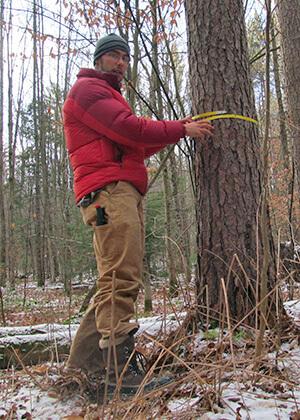I grew up just outside Amherst, Massachusetts in a town called Shutesbury. I came to UVM for a number of reasons: the lake, mountains, beautiful weather (especially the spring), the variety of options for different majors, and because a good friend from high school recommended it. I switched into the Rubenstein School my second semester to declare a major in Forestry after talking with John Shane, chair of the program at the time.
I have always found forests fascinating. I wanted to learn as much as I could about how forest ecosystems work and find a job where I could be outside and do something meaningful.
My senior year, I developed an independent project at the Jericho Research Forest (JRF). It was a year-long, for-credit project, funded by a Kate Svitek Memorial Award. I compared tree growth over a ten-year period across different forest types and management histories on several half-acre plots. The project required me to use a range of skills I had learned in my forestry education, from detailed forest measurement, to map and compass work, to GIS mapping. The results of my work are up at JRF on a large display board.
In Professor Bill Keeton’s silviculture class we visited the Audubon sanctuary in Huntington, Vermont to look at a new collaborative effort integrating traditional forest management and bird habitat management. Massachusetts has since developed a similar “foresters for the birds” program, and I recently completed one of the first management plans for that program as a forestry technician for Bay State Forestry Service.
I work as an assistant to three foresters at Bay State. During the summer and fall, I spend most of my time controlling invasive plants. The rest of the year is spent marking timber, meeting with loggers or landowners, writing management plans, doing boundary work, making maps, and doing other forest management-related tasks. I’m also working towards getting licensed as a forester in Massachusetts.
My favorite part of the job is meeting landowners who are really excited about their land. It is a big responsibility to have someone trust me to make decisions about what to do with their forest, which I find exciting and take very seriously. I love working outside every day.
There is no better way to really learn about the natural world than to spend all day immersed in it. I get a full spectrum of job sites. One day I might be crawling through a multiflora rose thicket (think big, nasty, thorny bushes if you don’t know what I’m talking about), another day wading through a swamp, and the next roaming through picturesque forest and farmland scenery. Still, on the days when it is 33 degrees and pouring, I’m usually happy if there is some office work to do.
As I see it, the modern consulting forester has a number of responsibilities. I am hired to meet the landowner’s goals but also need to make things work for the logger and wood industry as a whole. In addition, I have a responsibility to protect society’s forest-based natural resources for the long-term; not just trees, but also soil and water resources, wildlife, biodiversity, air quality and carbon stabilization, recreational opportunities, and a connection between humans and the natural world. The idea is to be able to benefit from the land without reducing its capacity to function as an ecosystem.
